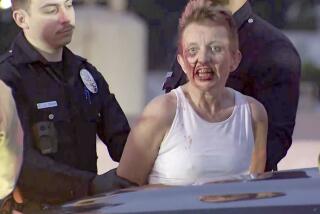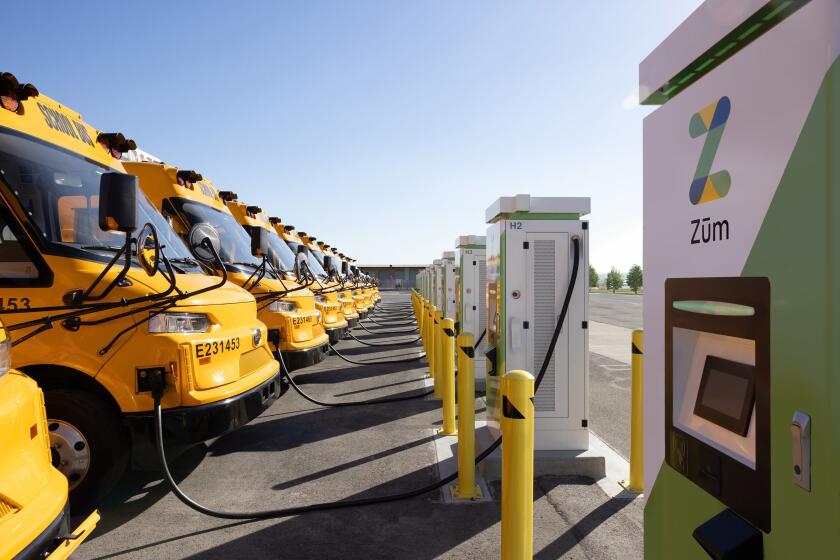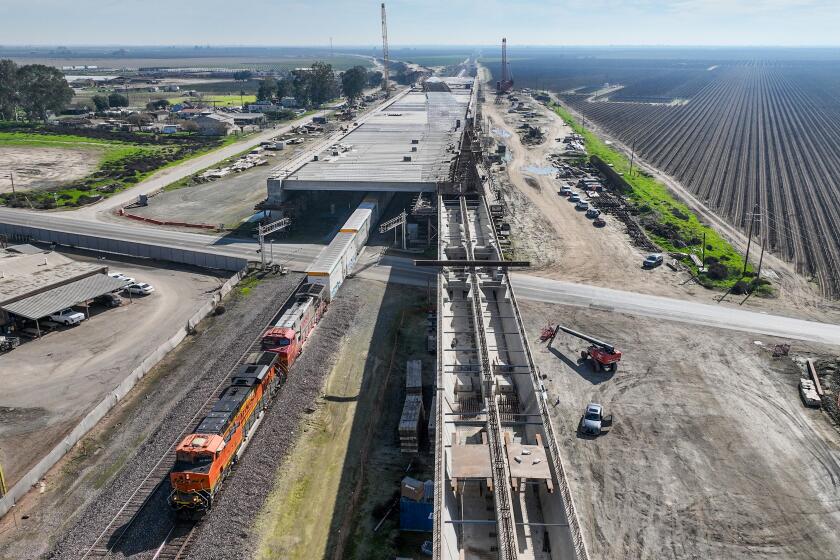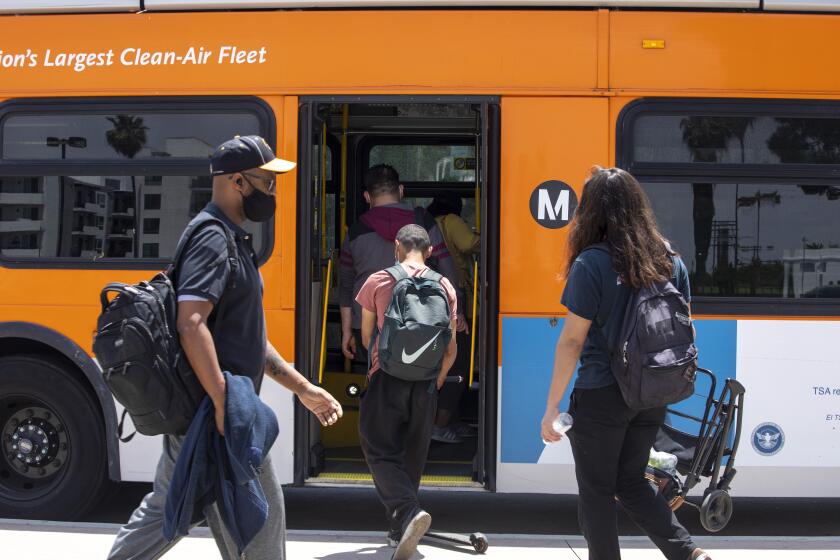The Long Shadow of Riot Coverage
No one waited for the morning paper when seeking early details about Tuesday morning’s crash in which a mile-long freight train ran through two warning lights and slammed head-on into a Metrolink commuter train.
Television was the logical choice, of course, as Los Angeles stations and 24-hour news networks moved swiftly to offer instant sound bites and striking pictures of a rail debacle so deadly that the collision site in Placentia resembled a combat zone.
It was signature live coverage from a news medium that speeds from one deafening boom to the next. That is not only helpful at times, but worthy of praise.
Yet TV news is also the caboose on its own runaway freight train of action and violence, one doomed by its own devices, unfortunately, never to catch up or see beyond the next blind curve. It’s usually first to arrive and react. When it comes to providing context and locating connections that enhance understanding, though, it’s pretty much a dismal flop.
That’s the case now, as it was a decade ago during the Los Angeles riots.
They erupted after a Simi Valley jury acquitted four white LAPD officers in the beating of African American motorist Rodney King, despite videotape of him being thrashed savagely as he lay on the ground. King had been drunk and speeding in a residential area when finally pulled over. He was no angel, but in the minds of many Los Angelenos, even less so were the cops who walloped him like a pinata or did nothing to stop the beating that night while being secretly taped by a nearby resident with a minicam.
No wonder the verdicts were greeted by outrage in parts of the city, exploding like a Molotov cocktail and touching off an urban inferno.
In some ways, the riots were the best of times for local stations--a story of broken windows and heads they could zoom to instinctively, with cameras rolling. If not for Bob Tur reporting live for KCOP from his chopper above turbulent Florence and Normandie in South-Central L.A., for example, Reginald O. Denny would probably be dead today. Denny was the white trucker who had been pulled from his vehicle by blacks and repeatedly kicked and smashed in the head with a brick and other objects as he struggled in a daze to rise from the pavement. Only after witnessing the attack on TV did four blacks courageously speed to that intersection and rescue Denny from his vicious assailants.
Mostly, though, it was the worst of times for local stations, as they wandered like mindless “Night of the Living Dead” zombies through one column of smoke after another, one looting after another and one chaotic hot spot after another, beaming back one live TV picture after another.
If Tur’s chopper footage was Denny’s savior, live knee-jerk coverage also was a big chunk of the problem, as stations, after talking nonstop legalese during the televised trial, went back to doing what they always did.
Chasing crime.
Some history: The riots could not have come at a worse moment media-wise, given the pitiful level of TV reportage here at the time, in part because stations had responded to the recessionary soft economy by replacing many seasoned reporters with lower-paid green ones. Covering a massive civil disturbance is challenging even for veterans. But these starry-eyed boys and babes arrived here with no tools at all to cover an outbreak of lawlessness that found many of them choking on fumes and their own adrenaline. Nor did they know much of the working-class areas being torched and decimated in what some would call an “uprising,” neighborhoods historically gripped by poverty, drugs, gang violence and police abuse.
Not that many of their more experienced TV colleagues performed much better, given their careers as generalists crisscrossing L.A. in news vans, their coverage of people of color limited mostly to live stand-ups while blacks and Latinos were led off in handcuffs or shoved into police cars.
Speaking for itself was the ugly reality of crimes by rioters, along with collateral damage and casualties. Almost surreal, though, was the commentary of reporters and especially some anchors who, roaring through their own warning lights, sought to earn their gaudy salaries by injecting themselves into stories and fearlessly dispensing advice to police and city government.
TV’s missteps were stunning. No one witnessing it would forget one reporter being debriefed by an anchor after she had watched a store looted in South Los Angeles. He: “Did you get the impression that a lot of those people were illegal aliens?” She: “Yes.”
How did she know? One concluded either that these TV sages were predisposed to believe that undocumented immigrants were automatically thieves or that the looters had “Illegal” stamped on their foreheads.
Also perilous were the mixed messages that stations delivered. Even as most anchors wisely called for cool, street reporters played airwaves Russian roulette by thrusting live mikes in front of anyone who would talk. Many obliged, including firebrands calling for violence in the streets as cameras spread their inflammatory tirades.
Meanwhile, several stations repeatedly reran the King video, surely aware of its potential to ratchet up anger. TV also egged on the very violence it was condemning by bathing in hot lights hostile demonstrations at Parker Center and other locations, blinding police and making them potential targets.
“If you want to turn your lights on,” one cop was heard shouting at a TV crew, “turn them on the crowd, not on the officers.”
There were subtler sins. Frequently referring to King only as “Rodney” tended to infantilize him, the equivalent of calling a black man “boy.” TV fed another misconception by focusing almost entirely on African Americans’ disapproval of the King verdicts, bolstering an us-against-them scenario that made it appear whites universally applauded the trial’s outcome. Not so.
Time often has a way of knotting loose ends. Two of the four acquitted police officers were later convicted in a second King trial in federal court, and physical debris from the riots vanished long ago, even though emotional residue remains.
How would stations respond if there were similar riots today? Would they be less impulsive and more responsible? One can only speculate, but watching them go berserk over Robert Blake’s recent arrest in connection with the murder of his wife bred no optimism.
As it turned out, many of the media were buried by the wreckage of their own performance 10 years ago, smoky ruins that have proved harder to clean up than the pockets of L.A. that came under attack.
*
Howard Rosenberg’s column appears Mondays and Fridays. He can be contacted at howard.rosenberg@latimes.com.
More to Read
Start your day right
Sign up for Essential California for news, features and recommendations from the L.A. Times and beyond in your inbox six days a week.
You may occasionally receive promotional content from the Los Angeles Times.






